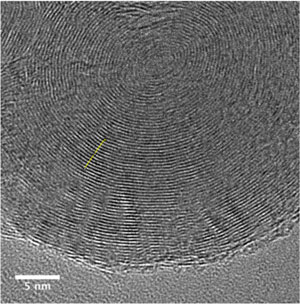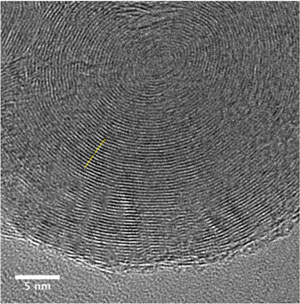 (Nanowerk Spotlight) Carbon nano onions (CNOs) are a singular structure with little research on the morphology of carbon nanomaterials, with extraordinary properties and a wide range of applications. This carbon form is mentioned in the literature-nested concentric buckyballs-with various terms such as onion-like structures, carbon nano-onions, carbon onions, carbon balls or nested fullerenes.
(Nanowerk Spotlight) Carbon nano onions (CNOs) are a singular structure with little research on the morphology of carbon nanomaterials, with extraordinary properties and a wide range of applications. This carbon form is mentioned in the literature-nested concentric buckyballs-with various terms such as onion-like structures, carbon nano-onions, carbon onions, carbon balls or nested fullerenes.
Stuart Licht, a professor of chemistry at George Washington University, told Nanowerk: "Carbon nano-onions have a wide range of applications, but these applications have been largely ignored because of their high cost of synthesis." "CNO applications Limited high surface area or symmetry of their morphology that is usually concentrated on rechargeable surfaces. For example, ultra-high-power supercapacitors have exceptionally high charge storage; the largest anode capacity lithium battery; increased capacity gas and energy storage materials; increased activity Heterogeneous catalysis; and solid lubricants in the form of super-strong "mini-ball bearings."

TEM of carbon nano onions. (Image: George Washington University Licht Group)
To date, the high cost and carbon footprint of producing CNO (by processing commercially available nanodiamonds, by burning of naphthalene, or by chemical vapor deposition) has become a considerable limitation for its application.
We have reported on previous work by the Licht group, who used molten carbonate chemistry to convert atmospheric carbon dioxide (CO 2) into valuable products such as carbon nanotubes or carbon nanofibers.
Licht called this method "aerial diamond", referring to the atmospheric CO 2 as a precursor and carbon as the material constituting the diamond, which also implies the high value of the product.
The process of converting greenhouse gas CO 2 into valuable products will stimulate its “mining” and removal from industrial flue gas or directly from the air, and may become an important component of climate change mitigation tools.
In the new work reported in the Advanced Sustainable Development System ("Carbon Nano Onions Directly Produced from CO 2 Directly by Melt Electrolysis to Reduce Greenhouse Gases"), Licht‘s team produced its "Aerial Diamond" chemistry as a high-yield route Cheap, stable carbon nano onions directly from carbon dioxide. Carbon dioxide reactants replace nanodiamonds as reactants to form nano onions.
In previous Nanowerk Spotlight, we reported the team‘s high yield of electrolytic conversion of CO 2 molten carbonate to CNT (known as the C2CNT process). In their new study, the researchers provided for the first time an exploration of the initial stages of molten carbonate electrolytic CNT growth, showing their relevance to the discovery and introduction of alternative high-yield carbon nanoonion synthesis.
By excluding CNT transition metal nucleation seeds, the C2CNT process (now better known as C2CNO) produces high-yield stable carbon nanoonions. In contrast to previous CNO synthesis methods, the only precursor was the use of CO 2 instead of diamond.
High-yield electrolytic synthesis of 2 from CO carbon nano onions, either directly from air or CO 2 from the chimney, in molten carbonate. (Image: George Washington University Licht Group)
The source of the CO 2 that produces these CNOs can be the consumption of industrial flue gas or the consumption of CO 2 captured directly from the air.
An economic assessment conducted in this article shows that this new process is extremely attractive. Licht states: "The highest estimated value for new chemistry and new methods for the production of CNO by molten carbonate electrolysis (excluding the cost of the anode to be determined) is $ 1,000 per ton, several orders of magnitude lower than other methods.
The team is currently working on large-scale production of CNO to accelerate the process‘ contribution to climate mitigation efforts, such as in their ongoing C2CNT Carbon XPrize final demonstration plant.
Licht concluded, "Our C2CNT research team is working to achieve a carbon-based economy whose changes are comparable to the introduction of the plastic economy." Replaced by stronger, more powerful carbon products, and provided the basis for removing the greenhouse gas carbon dioxide from the artificial carbon cycle. "
Source: nanowerk


 (Nanowerk Spotlight) Carbon nano onions (CNOs) are a singular structure with little research on the morphology of carbon nanomaterials, with extraordinary properties and a wide range of applications. This carbon form is mentioned in the literature-nested concentric buckyballs-with various terms such as onion-like structures, carbon nano-onions, carbon onions, carbon balls or nested fullerenes.
(Nanowerk Spotlight) Carbon nano onions (CNOs) are a singular structure with little research on the morphology of carbon nanomaterials, with extraordinary properties and a wide range of applications. This carbon form is mentioned in the literature-nested concentric buckyballs-with various terms such as onion-like structures, carbon nano-onions, carbon onions, carbon balls or nested fullerenes.

